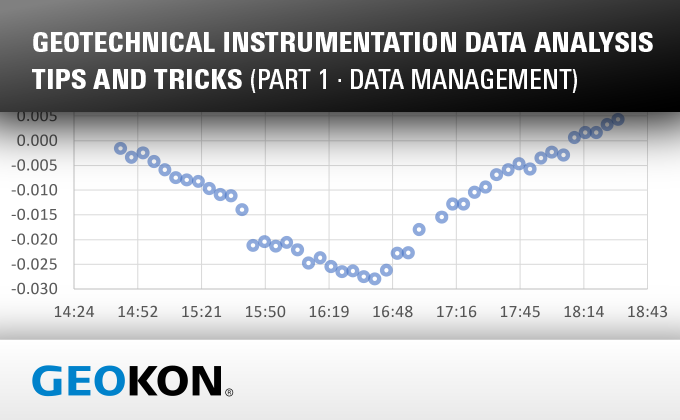 Loading... Please wait...
Loading... Please wait...-
Products
- Piezometers
- Inclinometers
- Strain Gauges
- Data Loggers
- Time Domain Reflectometry (TDR)
- Displacement Transducers
- Extensometers
- Settlement Sensors
- Pressure Cells
- Load Cells
- Tiltmeters · Pendulums
- Readouts
- Visualization Software
- Stressmeters
- Distributed Fiber Optic Sensors
- Temperature
- Instrumentation Cables
- DeAerators
- Vibration Monitoring
- Custom Instrumentation
- Discontinued
- Support
- Training
- Contact Us
- News
- Company
- Projects
- Resources
- Videos
- Links
Resources
Session 03
Geotechnical Instrumentation Data Analysis Tips and Tricks
(Part 1 • Data Management)

Posted November 18, 2021
Geotechnical instrumentation data analysis starts with good planning.
Define the geotechnical questions that need to be answered:
- Every instrument on a project should be selected and placed to assist in answering a specific question: If there is no question, there should be no instrumentation—Ralph Peck
Define the purpose of the instrumentation:
- Instrumentation should not be used unless there is a valid reason that can be defended—John Dunnicliff
To set up an instrumentation and monitoring program for success, start with defining the data management requirements for the project
Data Management
- Identify the parties involved and the needs of each party
- Define what success looks like before the project starts
- Select a data management system that is appropriate for your organization/project
- Conduct system validation testing (small scale pilot program)
- Management of factory calibration “sheets”
- procedure for updating calibrations
- Procedure for data screening
- Procedure for setting appropriate collection frequencies | reviewing schedules
- Data calculation instructions (with example)
- Procedure for plotting data (with example)
- Procedure for reporting data to Engineer of Record, owner, or stakeholder
- Automated systems shall include backups | data access | data security
Once the data management requirements are set, determine how data will be collected from each instrument on the project.
Data Collection
- Collection of instrumentation data
- Follow manufacturer’s recommendations
- Documented procedure for data collection
- Maintain field data records
- Personnel qualifications and responsibilities
- Training | Refresher Courses
- The role of automated data acquisition systems
- No automatic system can replace engineering judgement
- Role is to reduce non-value-added work
- Formal initial readings (on site zero reading at thermal equilibrium)
- Field calibration for nontraditional sensors
- High frequency readings until sensor/conditions are stable
- Lower frequency readings for monitoring
- Take readings at the rate at which site conditions are changing
- Consider construction activity
- Consider requirements of data transmission, processing, and interpretation
- Collection of unnecessary data should be avoided
- allowing attention to be focused on the critical parameters to be monitored which can provide early indication of a developing problem
- Subsets of instruments can be assigned for real-time monitoring
- to track the vital signs of the structure as a primary detection network and less frequent readings for designated secondary instruments
Now that the raw data is collected and managed in a systematic way, set the procedure for converted the raw data into engineering units that can be used to make quick, informed decision.
Data Processing
- Provide rapid assessment to detect changes requiring action
- Summarize and present data to:
- show trends
- compare observed with predicted behavior
- Should be automated wherever possible
- Raw data should always be retained
- Automated data conversions should be validated by a qualified person
- Personnel qualifications
- requires significant judgement
- do not delegate to inexperienced personnel
